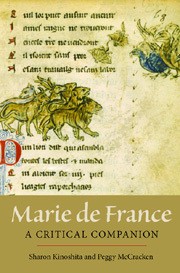Book contents
- Frontmatter
- Contents
- Preface
- Note on Editions
- 1 Introduction: the World of Marie de France
- 2 Communication, Transmission, and Interpretation: Literary History
- 3 Courtly Love and Feudal Society: Historical Context
- 4 Movement and Mobility: Plot
- 5 Bodies and Embodiment: Characters
- 6 Repetition and the Art of Variation: Narrative Techniques
- 7 Posterity: The Afterlives of Marie's Works
- Further Reading
- Index
- Already Published
4 - Movement and Mobility: Plot
Published online by Cambridge University Press: 12 September 2012
- Frontmatter
- Contents
- Preface
- Note on Editions
- 1 Introduction: the World of Marie de France
- 2 Communication, Transmission, and Interpretation: Literary History
- 3 Courtly Love and Feudal Society: Historical Context
- 4 Movement and Mobility: Plot
- 5 Bodies and Embodiment: Characters
- 6 Repetition and the Art of Variation: Narrative Techniques
- 7 Posterity: The Afterlives of Marie's Works
- Further Reading
- Index
- Already Published
Summary
Marie de France is a master of the episodic form. Her works unfold in relatively short narrative segments that are defined less by temporality than by movement. In her collection of lais, stories are structured by travel between places as well as by movement among conflicting obligations, desires, and value systems. Time passes, but its passage is not usually described with any urgency or explanation – why does Guig-emar's lady suffer for two years (and not one or three) before going to the shore to drown herself and instead finding the boat that takes her to the court where she will find her lover again? The Ysopë, a collection of episodic tales that move from forest to barnyard and from country to the city, mostly takes place in an unspecified present. And although Owein's journey in the Espurgatoire is bounded by time, his progression through Purgatory is described in episodes that correspond to the places and tortures through which he passes. In all Marie's works, time seems less important than place, and movement among places is one of the primary motors of plot.
Movement, like many other themes, works on a variety of levels in Marie's works. It may recall mouvance, in the form of changes to texts not just through transmission and transcription, but also through translation. As we noted in Chapter 1, vernacular literature in Old French has its origins in transcription and translation, and Marie's works are no exception.
- Type
- Chapter
- Information
- Marie de FranceA Critical Companion, pp. 113 - 142Publisher: Boydell & BrewerPrint publication year: 2012



